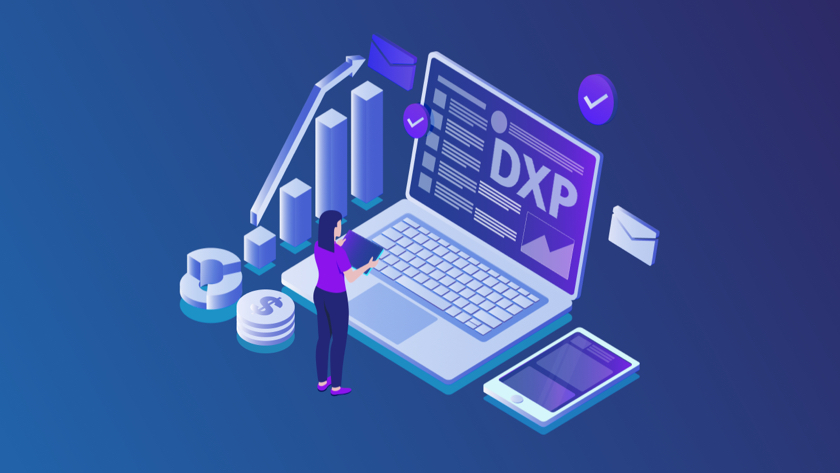Table of Contents
If you’ve ever encountered an ad for a product that you were looking for or if you’ve ever received a personalized offer from a brand on a holiday eve, it’s not because Big Brother is watching you. It is the result of a meticulous digital experience management process.
Companies can use various tools to deliver personalized user experience and the most efficient one is a digital experience platform (or DXP for short). A DXP helps companies engage with users across multiple touchpoints and allows creating and managing highly personalized content while keeping it in one place. But how does a DMX differ from other content management tools and what should companies consider before implementing it? Let’s find out.

Defining a digital experience platform
In a world full of content management solutions, it might be confusing to navigate through the available options. So what is a digital experience platform?
A digital experience platform is a software solution composed of various technologies that work together to assist organizations in delivering an exceptional digital experience. There are many digital experience platform examples, including Salesforce Experience Cloud, Liferay, and FirstSpirit. As for its main purpose, companies use DXPs for such business operations as:
- Multichannel content management;
- Customer relationship management (CRM);
- Big data and content analytics in real-time.
A DXP evolved from traditional CMS (content management system), so both solutions share similar features and help companies manage, create and analyze their content. However, a digital experience platform provides a more in-depth personalization of the customer experience due to its integration with other systems via APIs. This allows customer data across all digital touchpoints to be collected and connected into a single system with little to no effort.
The main types of digital experience platforms
Now, if you ever get asked «What is a digital experience platform?» you will know the answer. Let’s move on to the next topic — the DXP types.
In general, digital experience platforms fall into two categories — open and closed. An open DXP is a platform that unites solutions from different third-party vendors into a single system. An organization may be able to combine existing technologies with new ones or with those that are already in use.
A closed DXP is a platform that comes with all the needed tools built into it. Although a closed DXP can integrate with external products, it’s designed specifically to work within its own environment. When choosing between the two, rely on your personal preferences. You might want to stick with just one vendor or you may not have so many technologies to integrate into a single system — in this case, a closed DXP is your platform of choice. But if have plenty of tools to work with and want a certain level of flexibility and freedom, look for an open DXP solution.
Now, there is also a DXP classification based on their functions and features:
- CMS DXP: is used to help companies perform marketing analytics and segmentation based on user personas. Companies can use a CMS DXP to attract new customers, generate demand for a product/service, and provide personalized advertising (works particularly well in B2 °C scenarios);
- Commercial DXP: is used in e-commerce mostly and provides efficient inventory management, advanced shopping cart functionality, payment integrations, and many more. In addition, many commercial DXPs contain content management features for product promotion;
- Portal DXP: is used by both B2B and B2 °C companies (especially in fintech) to maintain long-term relationships with customers after the sale. This DXP type provides companies with suitable analytics to track and analyze customer loyalty, user retention, and engagement.
The main features of a digital experience platform
Now that we know about the main DXP types, let’s examine the common components that can be found in any DXP solution and bring so much value to companies.
CMS
A content management system (CMS) allows creating, editing, and managing all your content and gives users complete control over it. Being a core of the DXP, the CMS offers a repository for other services via the API. A CMS in a DXP (even if it’s not a full-fledged one) serves as a central point for your content and takes care of all processes related to it (i.e. indexing, delivery, security, and many more).
Analytics
Analytics is probably the most vital component of any DXP since the collected data needs to be studied and analyzed. A powerful analytics tool helps marketers track metrics and gain real-time data on user behavior (page visitors, consumed content) that can be further used to optimize the customer experience.
Personalization
Remember, we talked about the digital experience platform definition and how this solution provides exceptional customer experience? Hence, it makes sense that a personalization framework is an important DXP component. Digital experience platforms use machine learning and artificial intelligence to personalize recommendations based on real-time, continuous, and automatic customer data. In this way, organizations are able to provide relevant and personalized customer experience based on the following:
- The previous behavior of customers;
- Segmentation;
- AI/ML technologies;
- Outside data sources.
Integration capabilities
One more component of a DXP is strong integration with external systems. There are flexible APIs for content delivery or administration in every DXP that allow easy and quick integration with the needed solutions.
APIs can also be used to consolidate data across different platforms and drive rich content experiences (across all channels) and capture data from those channels.
The evolution of digital experience: from CMS and WEM to DXP
Over the years, the digital experience has been evolving to meet the changing needs of users. The shift from a CMS to WEM, and then to a DXP was powered by two main things: the use of different channels (from single channel to multi-channel) and a shift in content management (from content-centric to customer-centric). Let’s go a bit back in time and look at this evolution from the start:
- Content management systems (CMS): assist companies to create, manage and publish digital content across multiple platforms and contain such features as editing, reporting, SEO optimization, and many others. However, CMS does not offer deep personalization or complex web analytics;
- Web experience management (WEM): is able to identify user behavior and deliver more personalized content more accurately. A key feature of WEM is the separation of content management from content delivery and data centralization and consistency. However, WEM is difficult to integrate with other software solutions;
- Digital experience platform (DXP): helps to provide a personalized and streamlined digital customer experience across all touchpoints of a brand. An invaluable feature of DXP is its easy integration with other software solutions, which allows companies to gain a holistic view of customers.
All of these systems — CMS, WEM, and DXP — are striving to meet the needs of both brands and customers. But the ways in which they do that have changed. Most businesses now invest in robust DXP solutions.
And here is why.
The benefits of using a digital experience platform
As mentioned previously, digital experience platforms take a step further from content management systems since DXPs not only create an omnichannel customer experience but also drive business growth. As well, a digital experience platform offers the following benefits:
- Improved customer experience: a DXP helps companies collect customer data from multiple channels and thus, it provides better customer analysis and, as a result, better personalization;
- Reduced time-to-market: a DXP can access customer data effortlessly and allows to work on consistent and accurate data «on the go» thus speeding up the time to market through iterative delivery;
- Increased efficiency: DXP helps companies improve the performance of their campaigns by combining digital functions into one centralized platform and eliminating the need for any additional platforms;
- Advanced integration: a DXP allows various integrations with existing and new systems so that companies can deploy needed tools at any time;
- Saved costs: by smoothly merging multiple systems into a single DXP, companies can save costs usually associated with managing multiple platforms.
If a company aims to take its content management and user experience to a new level, choosing a well-matched DXP is critical. However, before choosing a DXP solution, a company must answer the key question: what is the main purpose behind the DXP implementation?
How do you choose the right digital experience platform?
To make a wise choice about selecting the right digital experience platform, a company should bear the following factors in mind:
- Budget: the cost of a DXP depends on the features required and the scale of the company’s operations;
- Business goals: a company needs to set clear DXP implementation goals, define a roadmap, and then look for a DXP solution that will help achieve the established goals;
- Integration with other solutions: companies must consider how well the new system will integrate with other solutions from their tech stack;
- Analysis of the Martech stack: a company should analyze the current Martech (marketing technologies) stack. The information obtained about the stack will help companies not only to plan but also to deploy and implement the right DXP solution.
Final thoughts
A digital experience platform allows organizations to become more user-focused while seamlessly managing complex content-related processes. However, that doesn’t mean a company should immediately adopt this technology to grow its business. A CMS or a WEM may still suffice for some brands to meet user expectations. Hence, everything will depend on your business needs, your future goals to achieve, and how critical the online presence is for your brand.



Comments